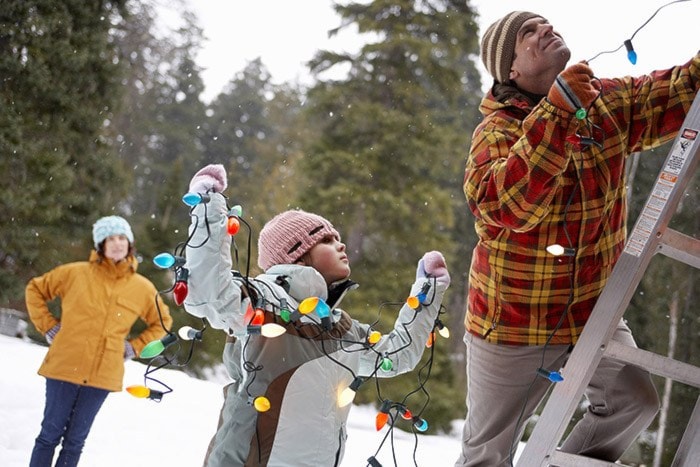It’s that time of year again when we patiently wait for a break in the rain so we can scamper out and put up our Christmas lights before the wet stuff returns.
And with the seemingly wider array of Christmas lighting and decoration options every year, it’s no wonder Christmas light installation services are flourishing on the Internet.
For the uninitiated, or those needing assistance, there is Christmas-light installation help from high-end, design-and-build services, to companies that will put your lights up, to a guy on Craigslist who will put your own lights up for a fee.
But for old-fashioned Christmas enthusiasts, putting up the lights can sometimes be as much a part of the holidays, and as rewarding, as appreciating the finished product when it’s all done.
Chevy Chase and National Lampoon picked up on this holiday phenomenon and ran with it in 1989’s Christmas Vacation. There’s a little bit of Clark Griswold, and his Christmas-light obsession, in all Christmas light enthusiasts.
So to avoid some of Clark Griswold’s missteps, experts in this field suggest that during these rainy November days we prepare and plan for the next non-rainy weekend.
Before starting, it’s suggested weekend installers step back and develop an overall game plan instead of just winging it. This could actually help reduce how wet you get if you find there’s no appropriately timed weather window and you have to put up Christmas lights in the rain.
Pick a focal point, such as the frame of your entryway, as the place you’ll want to start. Consider surfaces, gutter thickness and shingle flexibility to best determine how to hang lights along the roofline.
Popular spots for outdoor Christmas lights include along rooflines or eaves, on bushes, hedges and trees, around pillars, posts or deck railings, around windows, door frames, any architectural features, near driveways and pathways, and in window boxes and planters.
Measure any straight line you where you want to string lights to help determine how many strands you need. And measure the distance to your power source.
How many lights you’ll need to decorate trees and shrubs is a personal preference. But a good rule of thumb is 100 lights for every half metre (1.5 feet) of tree or shrub you want to cover. So a 6’7’’ evergreen would need around 400 lights for a basic level of lighting.
Test your lights. Lights need to be tested, even if they’re new. That can be done on the ground, prior to installation. The last place you want to find out your lights are busted is on top of a ladder in the cold.
There are many light types and colours so try to ensure you group the same light-type together. Try using white lights on your bushes, but coloured lights on your trees and entryway , and maybe top it off with white icicle lights along your roofline.
LED lights save money on energy costs and they don’t overheat.
Icicle lights look great on the eaves of your roof – just make sure to cluster them together. If stretched too far apart the look is completely lost.
For your bushes, try net lights. These are like a blanket of lights. Simply lay them on your bushes, and boom, you’re done.
In the event that your goal is to have your house visible from the International Space Station, then stagger two sets of lights side-by-side, or look for lights that are spaced closer together as denser lights give off brighter light.
Also, ensure that you are only using approved extension cords — specific for outdoor use — and that you look for lights rated specifically for indoor and outdoor use.
And be sure to check your light strands for frayed or damaged cords. They cannot be used at all as they are hazardous and could ruin your entire design.
Nowadays there are several light clips available that make light installation easier and safer. Forget staples, nails, or any other contraption you’ve used in the past for mounting lights to your house. Light clips are your new best friend.
There is some kind of clip for every surface, just read the packages to find one that best fits your situation.
Attach lights to shutters or shingles. To attach lights to your gutters, use an all-purpose light clip that works with any type of light. The same clip can usually be used to attach lights to shingles instead by flipping the clip around.
Attach lights to trees. If you’re hanging lights in a tree, try using a light-hanging pole, which is also a good solution if you don’t want to get on a ladder.
Set a timer. No one likes awaking in the morning to discover the Christmas lights have been on all night. So now that the lights are up, plug them into an outdoor timer. Some have light sensors that automatically turn on at dusk.
Hit the switch. Stand back and admire your Christmas creation with a cup of hot cocoa or eggnog.
– By Kevin Gillies, a freelance writer for Black Press.
